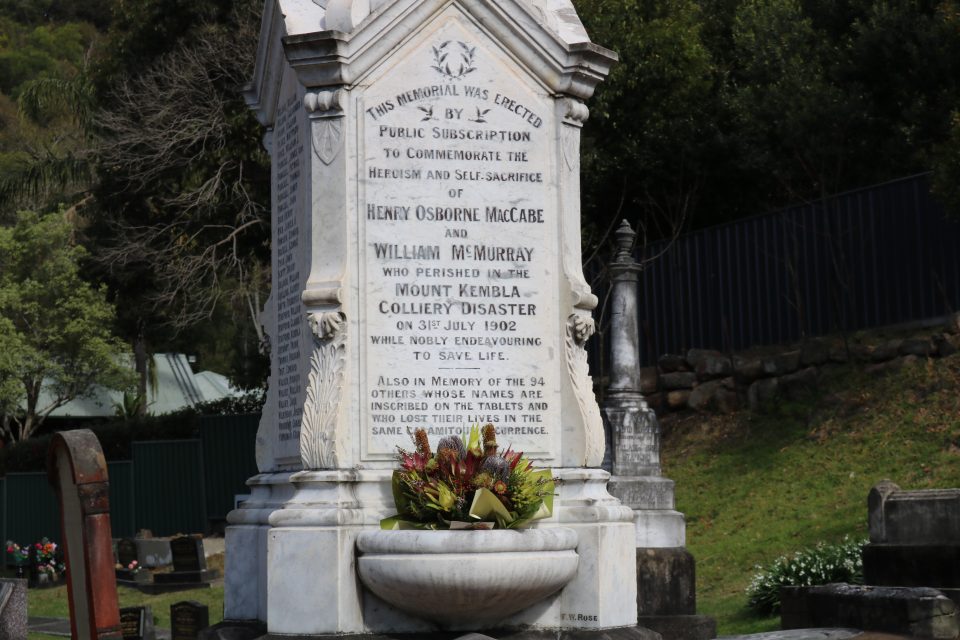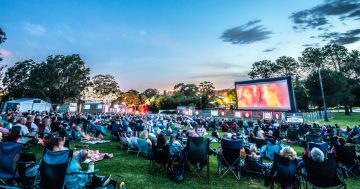
The monument to the victims of the mine disaster was originally placed in Wollongong in 1905 before being moved to the Soldiers and Miners Memorial Church in Mt Kembla. Photo: Jen White.
This article was written by Carol Herben for the Illawarra Historical Society in 2002, the 100th anniversary of the Mt Kembla mine disaster. It tells the story of the Mt Kembla Monument, which now stands next to the Soldiers and Miners Memorial Church in Mt Kembla.
The Illawarra Mercury of 9 August 1902 published a letter from a former Illawarra resident now residing in Sydney, who suggested a small, unpretentious and not too costly a monument be erected to the memory of Major MacCabe and W McMurray to be placed beside the monument of young Andrews (Trooper Andrews) near the Town Hall.
Also, a second monument, such as a horse trough, could be erected in memory of the miners and horses who died in the colliery.
The people of Wollongong showed some real interest in the idea of a monument. Over time, some 12 sites were suggested around Wollongong, among those the railway station and Brighton Beach.
Another site was on the corner of Crown Street and Crown Lane on the property of Samuel Cutcher. Samuel Cutcher was approached, but after too much pressure withdrew the sale.
The mayor of Wollongong called a meeting on 25 August 1903 to form a committee to proceed with the memorial. It was suggested that funds be raised by public subscription.
As the suggestions flowed in for sites and public subscriptions grew, a single monument was the final selection.
The decision of the committee by March 1905 was to place the monument in the middle of Church Street, right in front of the Presbyterian Church (which was then situated on the corner of Crown and Church Streets).
The Wollongong Burrough Council refused permission for the monument to be erected in Church Street in view that this would be too dangerous. The committee placed their sights then on the St Michael’s rectory gates facing Church Street.
It was at this time that Samuel Cutcher changed his mind and would donate the land for the erection of the monument.
Frederick William Rose, a master monumental mason, was duly contracted to craft the monument. He selected Italian marble. Rose also selected Pyrmont bluestone for the base and steps. The NSW Government waivered the import duty on the Italian marble.
It was during the process of engraving the monument that Frederick Rose had duly carved a cross as a symbolic gesture. He was informed that the monument was not erected for its religious aspect, but as a memorial for the town of Wollongong. The cross was duly removed from the monument.
Initially the monument was to be of small construction to honour the two fallen heroes MacCabe and McMurray, but as the subscriptions grew it was decided to include the names of all the miners.
Unfortunately, the finished work shows that consultation with the victims’ parents, widows or children was somewhat lacking.
Names such as Alexander J Nelson, Kembla Stafford and Charles Woodroof were not the names the families had issued for the death certificates and used as inscriptions on headstones.
In fact, the committee selected the names they thought were the correct names. Further to that is an entry of one Daniel Gallagher, whose actual existence has been doubted for some time.
The inscription on the front of the monument clearly states that the intent of the monument was for MacCabe and McMurray and added in smaller wording was, “Also in memory of the 94 others whose names are inscribed on the tablets and who lost their lives in the same calamitous occurrence”.
The monument today represents all 96 names rather than just the two who showed such heroism.






The official unveiling of the monument was planned for the afternoon of 12 August 1905, some three years after the disaster. A huge dais was erected for the dignitaries and seating was provided for the widows and families of the disaster victims. Some 4000 to 5000 citizens attended the official unveiling.
An “In Memoriam” service was held at 8 pm and was attended by some 1500 to 2000 people.
A total of £180-5-4 was raised by public subscription. The total cost of the materials was £174-l-6 which left an excess of £6-3-10 which the committee decided would go towards better lighting of the monument.
At the time of the unveiling of the monument the town of Wollongong was lit by gas. The first lighting apparatus installed on the top of the monument was a straight pair of arms which held flat open shades.
Lighting of the monument in 1905 was insufficient and the committee decided to spend the excess money on better lighting.
A new set of curved arms and shades were manufactured from cast iron and installed on top of the monument.
By the time Wollongong had advanced to electricity in 1925 a new set of shades were mounted on the curved arms of the monument. The change from straight arms to curved arms brought about a change in the urn mounted on top of the monument.
A shorter, broader urn was crafted for the top. In all, the monument changed appearance at least three times while in Crown Street.
The initial site was the intersection of Crown Street and Crown Lane from 1905 until 1937.
When first erected the bluestone base sat on three steps. With the introduction of motorised vehicles and the sealing of the road, by the 1920s the lower step was sealed under the road surface.
The second step was at road level by 1937 and the monument was becoming a traffic hazard.
So the monument was dismantled and re-erected in the Wollongong Rest Park between Globe Lane and Burelli Street. The bluestone steps were not placed under the monument in the park, it only sat on the bluestone base.
In 1973 the monument was dismantled once more and transported in five pieces and erected next to the Soldiers and Miners Memorial Church in Mt Kembla.
At the time of the erection of the monument in the churchyard the column was accidentally reversed.
Overall this now gives the monument a different appearance along with the loss of the lighting arms.
Over the years the monument has been altered in appearance and reduced in height by some 60 to 70 centimetres.
In 2002, the centenary year of the disaster, a stonemason who specialises in the restoration of old monuments and headstones, was engaged to clean the monument. This was undertaken at a cost of $2000.












